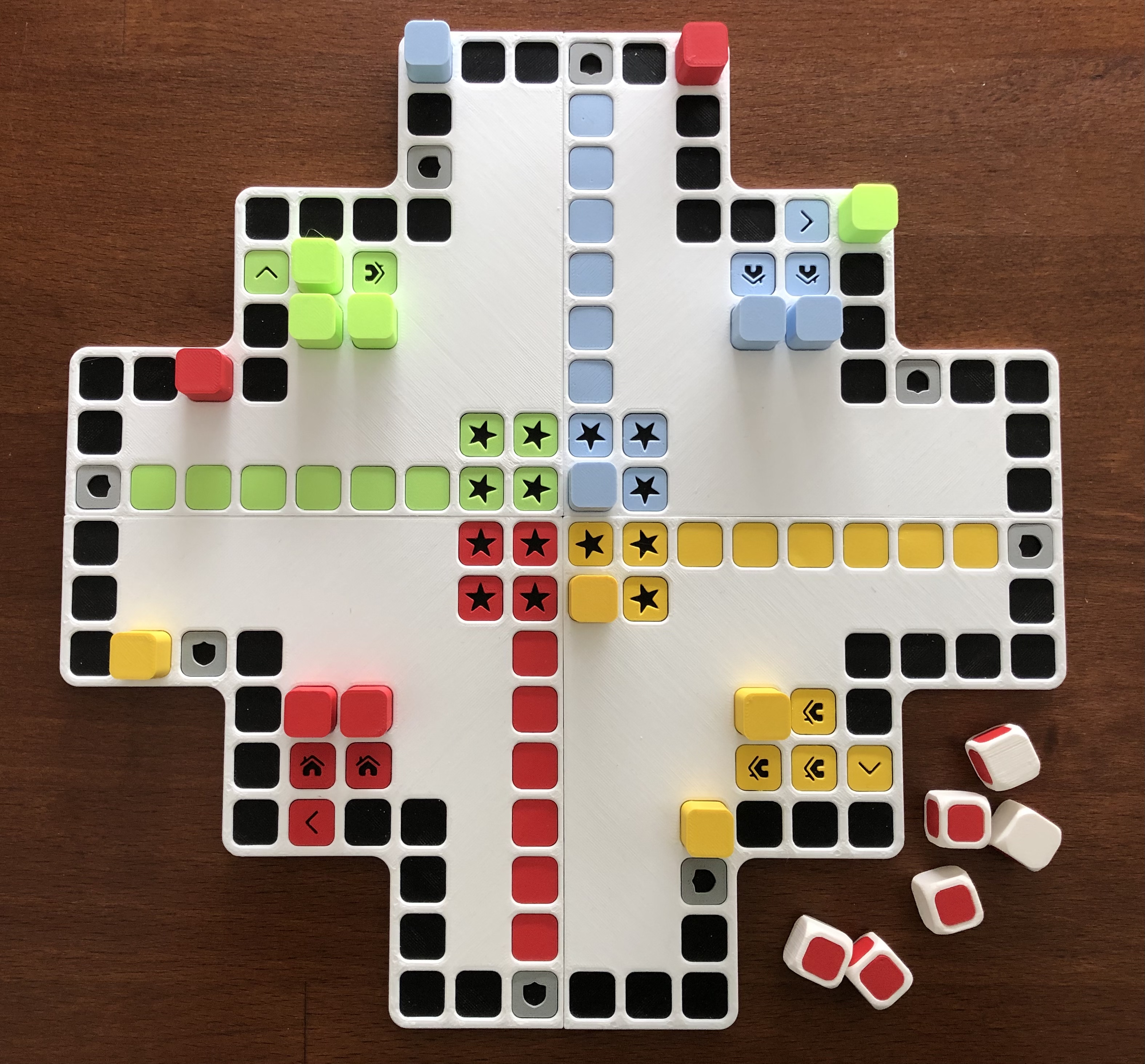
Pachisi the ancient board game
prusaprinters
<figure class="image image-style-align-right"><img src="https://media.printables.com/media/prints/153446/rich_content/9cf72848-906f-42f7-b919-baef8f06ccf1/pachisi_fatehpur_m.jpg#%7B%22uuid%22%3A%22708f3f3b-b591-4320-a5c2-997718e10c1b%22%2C%22w%22%3A220%2C%22h%22%3A165%7D"></figure><p><strong>Pachisi</strong> is a racing game that originated in ancient India. It is played on a board shaped like a symmetrical cross. </p><p>There are places in Agra and Allahabad, where the emperor used to play on big Pachisi boards with red and white marbled squares, being the living pieces of 16 concubines from his harem. It´s very similar to Ludo, introduced in England in 1896. Ludo has directly inherited from the Indian game Pachisi. </p><p>I designed a modern version of the game.</p><h3>Print Instructions</h3><p>No MMU is needed. I designed different color tiles that you can just glue into the place. You need 16 of 4x4mm magnets to hold the 4 board parts together. As an alternative, you can just glue them together and/or use the “optional_no_magnet_stick.stl” instead of magnets.</p><p>Dice are binary. 3 sides of the die are blank and the other 3 sides are marked with color. Find more about the points below. </p><p>Print the different sets of tiles in 4 different colors. Print the 8 safe tiles in gray. <br>Print instruction: PLA, 15% infill, 0.20mm layer height. </p><ul><li>Board x4. (you can do a color change when printing just like on the photos. I have included a 3mf file with the color change)</li><li>Blank_tile x6 for each color. </li><li>Finish_tile x4 for each color. </li><li>Home_tile x4 for each color. </li><li>Arrow_tile x1 for each color. </li><li>Safe_tile x 8 in grey or in some dedicated color you don't use for the players. </li><li>Players x4 for each player. </li><li>Die x 6 + 18 die colored tiles</li></ul><p>Just follow the photos.</p><h3><strong>Rules of Pachisi</strong></h3><p>Each player has his own color, using one of the groups of pieces. Pieces start from their home area. (marked with House) </p><p>The first player who moves all of his pieces to the finish tiles wins the game. <br>Players take turns in clockwise order. Each turn, 6 dice are thrown.</p><p>Steps by dice thrown:<br><img src="https://media.prusaprinters.org/media/prints/153446/rich_content/caed92e0-65f0-44c4-88a8-bb3874ebb582/dice.png#%7B%22uuid%22%3A%22d071cad9-d25e-4385-a690-5267bdaff37d%22%2C%22w%22%3A950%2C%22h%22%3A520%7D"></p><p><strong>Advantage </strong>is a special part of the game. Players move their pieces around the board in clockwise order. <br><br>The first piece for each player can leave the home area <strong>using any number.</strong> Going further, the player can only move pieces from the home area by throwing an <strong>advantage</strong>. Pieces start their track on the tile marked with an arrow. <br><br>Pieces move around the track given by the number thrown. </p><ul><li>Multiple pieces of the same color <strong>can </strong>occupy the same space. </li><li>If no piece can legally move according to the number thrown, play passes to the next player.</li><li>When a piece lands on the finish area, another piece of the same color can immediately move<strong> forward 10 spaces </strong>when possible.<br> </li></ul><h3>Capturing </h3><ul><li>If a piece lands on a piece of a <strong>different color</strong> that is <strong>not on a safe space</strong>, the piece jumped upon is captured and <strong>returned to its home area</strong>. The capturing player can then immediately move any piece on the track 20 spaces forward when possible.</li></ul><h3>Barriers</h3><ul><li>Barriers are made by placing a piece in any space occupied by another piece of the same color.</li><li>A barrier cannot be landed on or passed by any piece, <strong>even of the same color</strong>.</li><li>Barriers should be opened (one of the pieces that are part of the barrier must be moved) when the player uses the corresponding color throws <strong>advantage</strong> or when he cannot legally move any other of his pieces. </li><li>A move is not possible if the piece cannot complete the advance of all the spaces marked by the die before colliding with a barrier.</li></ul><h3><strong>Safe Spaces</strong></h3><ul><li>Safe spaces are marked with a shield sign. </li><li>Arrow signs are safe spaces too. </li><li>Captures are not possible in safe spaces </li><li>When advancing to an occupied safe space, the piece stays together with the piece that previously was there</li><li>No more than two pieces may occupy the same safe space.</li><li>The move is not possible if the advance has to finish in a safe space occupied by two pieces.</li></ul><h3><strong>Throwing a Six</strong></h3><ul><li>A throw of 6 gives another turn unless it is the 3rd six in a row.</li><li>If 3 sixes are rolled in a row, on the third six, instead of a normal move, the piece moved on the previous throw of six (if any) is immediately returned to the home area – unless it was on the finish track in which case it is safe and is not returned.<br> </li></ul><h3><strong>Winning</strong></h3><p><br>When a piece has circumnavigated the board, it proceeds up the <strong>finish column</strong>. A piece can only be moved onto the finish area by an exact throw. As soon as a piece reaches the finish area it doesn't matter which finish tile it's placed on. The finish area is considered one unit. </p><p>Each <strong>finish column</strong> is only open for pieces of the same color.<br><br>The first person to move all 4 pieces into the finish area wins.</p><figure class="image image-style-align-center image_resized" style="width:50%;"><img src="https://media.prusaprinters.org/media/prints/153446/rich_content/723d59c7-ca23-4142-9ce8-cc1cfe4bb8a3/coffee.png#%7B%22uuid%22%3A%22a3661081-24ba-4bd5-9b9c-74f73cb3af07%22%2C%22w%22%3A436%2C%22h%22%3A228%7D"></figure><h4><a href="https://www.buymeacoffee.com/peterv">I run on Coffee, click here to buy me one</a>.</h4><p> </p><h3>Variant for two players</h3><p>Pachisi may also be played between two players.</p><p>Each of them will play with two colors (8 pieces), placed in opposite corners of the board.</p><p>In practice, this variant increases the strategic possibilities and reduces the importance of choice.</p><p>Although the rules are the same in both variants, some explanations are needed:</p><ul><li>Turns are for players, not for colors, so they may choose any of the eight own pieces for each move, even in the same turn.</li><li>Different colored pieces can always capture each other, even though both correspond to the same player. The 20 square moves may be made with any of the pieces of the player who makes the capture.</li><li>Barriers cannot be made with pieces of different colors, although they belong to the same player.</li></ul>
With this file you will be able to print Pachisi the ancient board game with your 3D printer. Click on the button and save the file on your computer to work, edit or customize your design. You can also find more 3D designs for printers on Pachisi the ancient board game.
